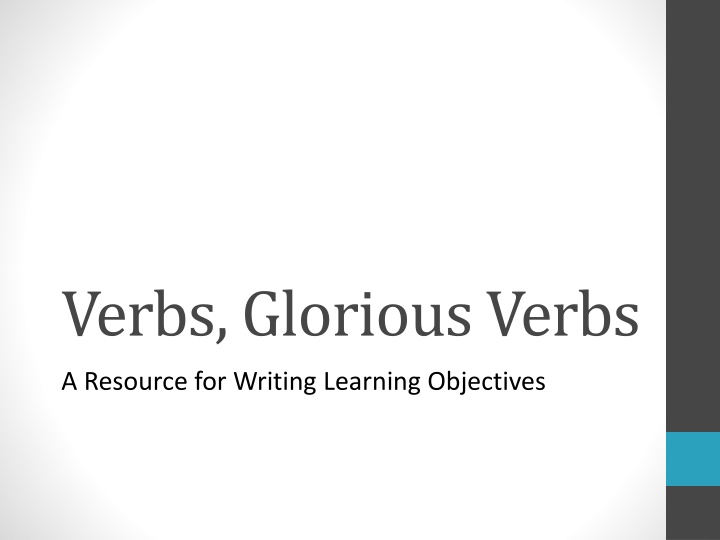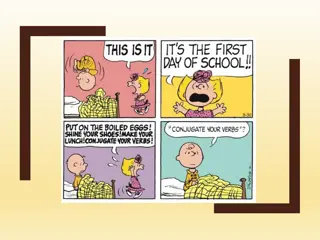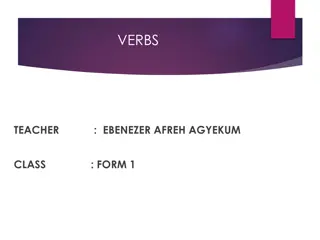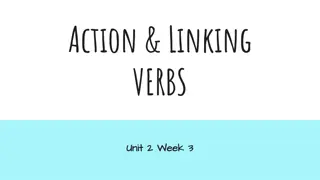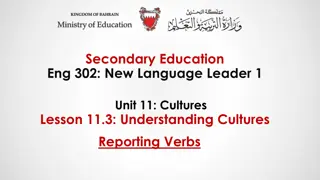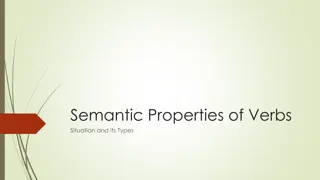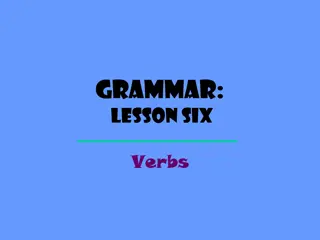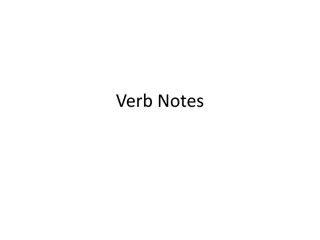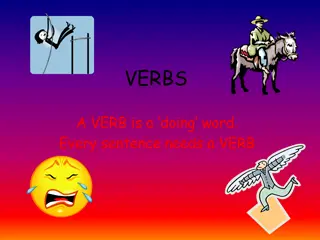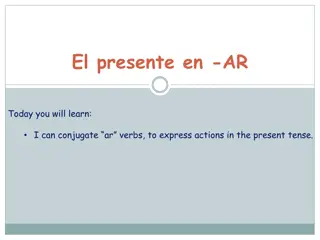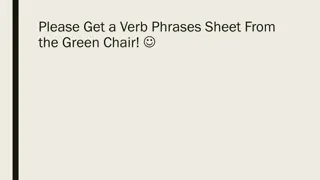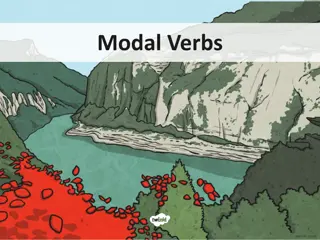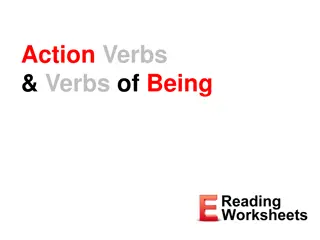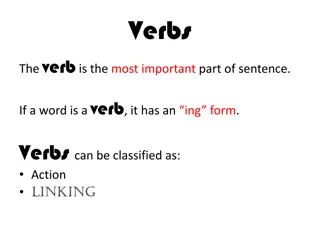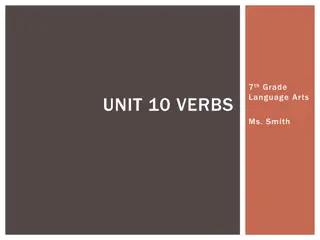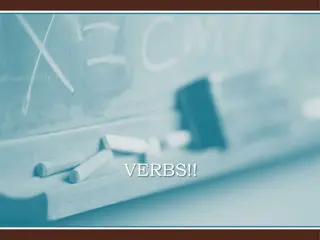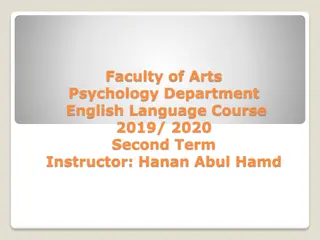Crafting Effective Learning Objectives Using Action Verbs
Crafting measurable learning outcomes involves focusing on student behaviors, using specific action verbs, selecting appropriate assessment methods, and setting clear performance criteria. The checklist provided emphasizes the importance of observable and measurable outcomes, incorporating active verbs from cognitive, affective, and psychomotor domains, and aligning outcomes with program requirements. Understanding Bloom's Taxonomy can aid in structuring learning objectives effectively.
Download Presentation

Please find below an Image/Link to download the presentation.
The content on the website is provided AS IS for your information and personal use only. It may not be sold, licensed, or shared on other websites without obtaining consent from the author.If you encounter any issues during the download, it is possible that the publisher has removed the file from their server.
You are allowed to download the files provided on this website for personal or commercial use, subject to the condition that they are used lawfully. All files are the property of their respective owners.
The content on the website is provided AS IS for your information and personal use only. It may not be sold, licensed, or shared on other websites without obtaining consent from the author.
E N D
Presentation Transcript
Verbs, Glorious Verbs A Resource for Writing Learning Objectives
Effective Outcomes Learning outcomes are not about what the instructors can provide, but what the students can demonstrate. When writing a measurable learning outcome, it is important to: o focus on student behavior o use simple, specific action verbs o select appropriate assessment methods o state desired performance criteria
Writing Learning Outcomes Typically we employ a stem phrase in stating outcomes: e.g. The student will be able to A graduate of this program shall be able to What follows that phrase is an active verb drawn from one of three domains: o Cognitive - knowledge and dealing with that knowledge o Affective - beliefs, attitudes values o Psycho-motor sequence of motion, prescribed task
Focus on the Observable Observable Performance write praise operate analyze organize demonstrate describe Non-observable Performance understand know learn remember enjoy perceive become familiar with
Checklist for writing learning outcomes Focus on outcomes, not processes Start each outcome with an action verb Use only one action verb per learning outcome Avoid vague verbs such as know and understand Check that the verbs used reflect the level of learning required Ensure that outcomes are observable and measurable Write the outcomes in terms of what the learner does, not what the instructor does Check that the outcomes reflect knowledge, skills, or attitudes required in society and the workplace Include outcomes that are woven into the entire course (such as work effectively in teams) Check that there are the appropriate number of outcomes (no more than three per major topic) List the sub-outcomes (learning tasks) for each outcome Check that the outcomes fit within your program and TWU SLO s Adapted from http://kb.bcit.ca/files/articles/fsr/teach/courseprep/ja_learningoutcomes.pdf
Blooms Taxonomy The Work of Bloom (1956) and Anderson and Krathwohl (2001) has given a way of thinking about various levels of learning in three domains . o Cognitive domain - knowledge and dealing with that knowledge o Affective domain - beliefs, attitudes values o Psycho-motor domain - sequence of motion, prescribed task
Cognitive Domain Category Associated Verbs/Actions Recall, remember, match, select, identify, choose, order, outline Remember Plot, define, summarize, classify, describe, present, explain Understand Propose, audit, edit, predict, construct, use, show, solve, compute Apply Distinguish, differentiate, investigate, scrutinize, consider, question Analyze Appraise, assess, judge, critique, comment, examine, interrogate Evaluate Develop, design, devise, generate, propose, build, form, assemble Create
Affective & Psychomotor Domains As with the Cognitive domain there are levels of learning Psychomotor Domain Affective Domain 1. Imitation 1. Receiving 2. Manipulation 2. Responding 3. Precision 3. Valuing 4. Articulation 4. Organization 5. Naturalization 5. Characterization
Simple Outcomes Verbs Psychomotor Cognitive Affective Accommodate Ask Describe Follow Give Hold Identify Listen Locate Name Point Respond Select Cite Copy Define Explain Identify Indicate Itemize Label List Locate Match Mate Name Outline Quote Recite Recognize Respond Reproduce Repeat Report Restate Select State Say Specify Translate Demonstrate Distinguish Complete Hear Identify Locate Move Practice Point to Press Pull Push See Select Setup Show Specify Sort Touch
Intermediate Outcomes Verbs Psychomotor Assemble Activate Adjust Cognitive Affective Apply Convert Demonstrate Assist Approve Choose Build Calibrate Close Distinguish Draft Dramatize Draw Employ Commend Complete Comply Construct Copy Conform Describe Form Demonstrate Estimate Follow Disassemble Disconnect Explain Extend Initiate Draw Invite Generalize Duplicate Execute Fasten Give Example Illustrate Infer Join Justify Perform Practice Fix Operate Propose Grasp Insert Lift Paraphrase Predict Prepare Share Study Locate Work Rewrite Loosen Load Schedule Summarize Manipulate Use Measure Open Operate Perform Remove Replace Rotate Set Slide Signal Tighten Trace Turn Twist
Complex Outcomes Verbs Psychomotor Cognitive Affective Assess Act Devise Generate Organize Plan Repair Adapt Combine Compose Construct Design Adapt Adhere Change Defend Display Influence Integrate Mediate Organize Revise Solve Verify Analyse Compare Conclude Contrast Convert Create Criticize Compose Design Diagram Discriminate Differentiate Evaluate Formulate Generate Manipulate Modify Organize Originate Plan Predict Prepare Propose Rate Select Value
Verbs Related to Particular Tasks Producing a Sequence of Words Dealing with two or more stimuli Using concepts Producing a single isolated response Producing a sequence of motion Using principles Combining two or more principles Information Collection and Processing Work Decision-making Work
Producing a Sequence of Words to cite to copy to enumerate to letter to list to quote to recite to record to reiterate to repeat to reproduce to (re)state to transcribe to type to choose
Dealing with two or more stimuli to compare to contrast to couple to decide to detect to differentiate to discern to distinguish to isolate to judge to match to mate to pair to pick to recognize to select
Using concepts to allocate to arrange to assign to catalogue to categorize to characterize to classify to collect to divide to file to grade to group to index to inventory to itemize to order to rank to rate to reject to screen to sort to specify to survey to tabulate
Producing a single isolated response to place to press to pull to recognize to repeat to reply to respond to rotate to set to signal to slide to tighten to touch to twist to associate to give a word for to grasp (w/ hand) to hold to identify to indicate to label to lift to locate to loosen to move to name to pick up
Producing a Sequence of Motion to activate to adjust to align to close to copy to (dis)assemble to (dis)connect to draw to duplicate to insert to load to manipulate to measure to open to operate to remove to stencil to trace to tune to turn off/on
Using Principles to anticipate to calculate to calibrate to check to compile to compute to conclude to construct to convert to coordinate to correct to deduce to define to demonstrate to design to determine to diagram to equate to estimate to evaluate to examine to expect to explain to extrapolate
Using Principles to figure to foresee to generalize to illustrate to infer to interpolate to interpret to monitor to organize to plan to predict to prescribe to program to project to schedule to solve to translate to verify
Combining two or more principles to accommodate to adapt to adjust to to analyze to compose to contrive to correlate to create to develop to devise to diagnose to discover to find a way to invent to realize to reason to resolve to study to synthesize to think through to troubleshoot
Supervisory and Management Work advise analyze appraise approve assess assign compare conduct contact counsel determine diagnose draft establish estimate forecast implement initiate interpret Interview Investigate maintain
Supervisory and Management Work manage monitor negotiate observe orient participate perform plan prepare process recommend review schedule sign study submit supervise verify
Information Collection and Processing Work analyze ascertain audit calculate check compile compute confer consult count diagnose gather identify inspect interview inventory locate measure observe obtain
Information Collection and Processing Work proof receive review verify weight
Decision-making Work approve compare decide determine estimate evaluate judge rate test
Further Resources Unless otherwise noted, the above is adapted from PIDP 3210 Curriculum Development, British Columbia Provincial Instructor Diploma Program, a program of the Ministry of Advanced Education, Innovation and Technology and offered by Vancouver Community College. See also: http://www.assessment.uconn.edu/docs/HowToWriteObjective sOutcomes.pdf For other Faculty Development Resources head to : www.twu.ca Research Faculty Development Events and Services Teaching Tip Bulletins
